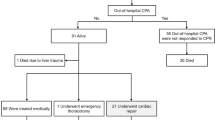Abstract
Background:
This work attempted to define the care and course of those most severely affected patients in the setting of blunt chest trauma, who had hypotension refractory to routine fluid resuscitation.
Methods:
Twenty-three critically ill blunt trauma ICU patients were resuscitated and enrolled with ongoing hypotension required placement of a pulmonary artery catheter. The REF®Explorer (Baxter, Edwards, Anaheim, CA) catheter was placed in the right heart measuring pressure, volume and oxygen utilization information, as well as recording Injury Severity Score, EKG, CXR, CPK/MB and echocardiography over the initial 72-h time period.
Results:
There were an approximately 2,300 Level I trauma patients admitted annually over a 4-year period with an overall mortality rate of 4.3% (100) patients with 3.4% (79) patients “ruling in” with elevated cardiac enzymes, associated with an increased mortality rate of 6.7% (p < 0.05). The 23 patients were male (17, 74%), mean age 41.2 years, with no past medical history (19, 83%), in a motor vehicle accident (21, 91%), with pulmonary injury (9, 39%), undergoing celiotomy in (10, 44%). They presented with moderate to severe trauma acuity defined as mean GCS of 8.6, TS of 11.3, and ISS of 34 with an increased mean hospital stay of 15 days versus 6 days in the ICU; and a 26 days versus 10 days overall stay for those with myocardial contusion (p < 0.05). Analysis of diagnostic variables found an abnormal EKG in (21, 91%), CXR in (20, 87%) and echocardiogram in (8, 37%). The total CPK was found to be elevated, mean 2,219 (204–8,278 U/l), while the MB fraction was normal 2.3 ± 1.3%. Invasive cardiac monitoring found an increase in CO of 1.6 l/min from 5.9 to 7.8 l/min during the first 24 h of recovery. Survival was worsened with increased ISS (29 vs. 43) p < 0.02, but improved with longer ICU (17 vs. 8) p < 0.03 and hospital (39 vs. 7) p < 0.05 stay in days. The analysis of commonly used diagnostic modalities – EKG, CXR, ECHO, or CO, did not correlate with survival, but the total CPK was increased in survivors (2,715 vs. 1,432 U/l) p < 0.009.
Conclusion:
There is worsened morbidity with a 2-fold increase in ICU LOS and hospital stay, and a 1.5-fold increase in mortality in the severe myocardial contusion group. The diagnostic dilemma posed by lack of definitive testing continues unresolved after analysis of routinemodalities – EKG, CXR, ECHO, CPK or CO – failing to yield a “best test”.
Similar content being viewed by others
Author information
Authors and Affiliations
Corresponding author
Rights and permissions
About this article
Cite this article
Vukmir, R.B. The Outcome of Cardiac Dysfunction in Critically Ill Trauma Patients: Myocardial Contusion Complicated by Refractory Hypotension. Eur J Trauma Emerg Surg 34, 261–266 (2008). https://doi.org/10.1007/s00068-007-7062-0
Received:
Accepted:
Published:
Issue Date:
DOI: https://doi.org/10.1007/s00068-007-7062-0




